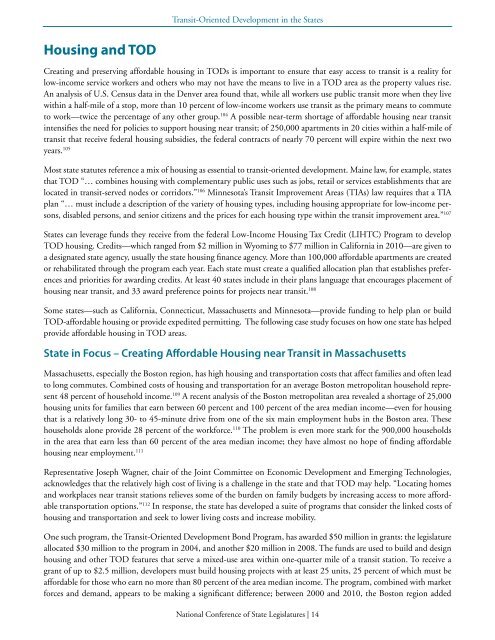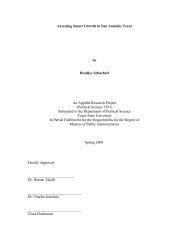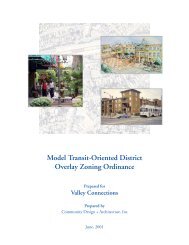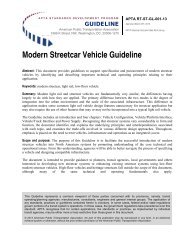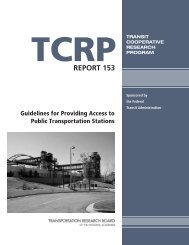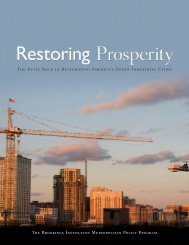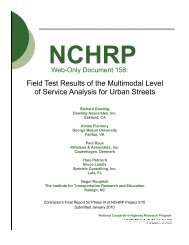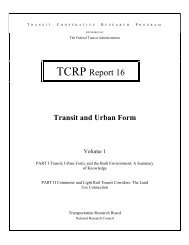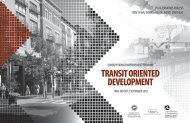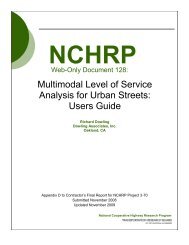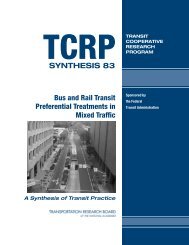Download the full report (PDF, 734 KB) - Reconnecting America
Download the full report (PDF, 734 KB) - Reconnecting America
Download the full report (PDF, 734 KB) - Reconnecting America
- No tags were found...
Create successful ePaper yourself
Turn your PDF publications into a flip-book with our unique Google optimized e-Paper software.
Transit-Oriented Development in <strong>the</strong> StatesHousing and TODCreating and preserving affordable housing in TODs is important to ensure that easy access to transit is a reality forlow-income service workers and o<strong>the</strong>rs who may not have <strong>the</strong> means to live in a TOD area as <strong>the</strong> property values rise.An analysis of U.S. Census data in <strong>the</strong> Denver area found that, while all workers use public transit more when <strong>the</strong>y livewithin a half-mile of a stop, more than 10 percent of low-income workers use transit as <strong>the</strong> primary means to commuteto work—twice <strong>the</strong> percentage of any o<strong>the</strong>r group. 104 A possible near-term shortage of affordable housing near transitintensifies <strong>the</strong> need for policies to support housing near transit; of 250,000 apartments in 20 cities within a half-mile oftransit that receive federal housing subsidies, <strong>the</strong> federal contracts of nearly 70 percent will expire within <strong>the</strong> next twoyears. 105Most state statutes reference a mix of housing as essential to transit-oriented development. Maine law, for example, statesthat TOD “… combines housing with complementary public uses such as jobs, retail or services establishments that arelocated in transit-served nodes or corridors.” 106 Minnesota’s Transit Improvement Areas (TIAs) law requires that a TIAplan “… must include a description of <strong>the</strong> variety of housing types, including housing appropriate for low-income persons,disabled persons, and senior citizens and <strong>the</strong> prices for each housing type within <strong>the</strong> transit improvement area.” 107States can leverage funds <strong>the</strong>y receive from <strong>the</strong> federal Low-Income Housing Tax Credit (LIHTC) Program to developTOD housing. Credits—which ranged from $2 million in Wyoming to $77 million in California in 2010—are given toa designated state agency, usually <strong>the</strong> state housing finance agency. More than 100,000 affordable apartments are createdor rehabilitated through <strong>the</strong> program each year. Each state must create a qualified allocation plan that establishes preferencesand priorities for awarding credits. At least 40 states include in <strong>the</strong>ir plans language that encourages placement ofhousing near transit, and 33 award preference points for projects near transit. 108Some states—such as California, Connecticut, Massachusetts and Minnesota—provide funding to help plan or buildTOD-affordable housing or provide expedited permitting. The following case study focuses on how one state has helpedprovide affordable housing in TOD areas.State in Focus – Creating Affordable Housing near Transit in MassachusettsMassachusetts, especially <strong>the</strong> Boston region, has high housing and transportation costs that affect families and often leadto long commutes. Combined costs of housing and transportation for an average Boston metropolitan household represent48 percent of household income. 109 A recent analysis of <strong>the</strong> Boston metropolitan area revealed a shortage of 25,000housing units for families that earn between 60 percent and 100 percent of <strong>the</strong> area median income—even for housingthat is a relatively long 30- to 45-minute drive from one of <strong>the</strong> six main employment hubs in <strong>the</strong> Boston area. Thesehouseholds alone provide 28 percent of <strong>the</strong> workforce. 110 The problem is even more stark for <strong>the</strong> 900,000 householdsin <strong>the</strong> area that earn less than 60 percent of <strong>the</strong> area median income; <strong>the</strong>y have almost no hope of finding affordablehousing near employment. 111Representative Joseph Wagner, chair of <strong>the</strong> Joint Committee on Economic Development and Emerging Technologies,acknowledges that <strong>the</strong> relatively high cost of living is a challenge in <strong>the</strong> state and that TOD may help. “Locating homesand workplaces near transit stations relieves some of <strong>the</strong> burden on family budgets by increasing access to more affordabletransportation options.” 112 In response, <strong>the</strong> state has developed a suite of programs that consider <strong>the</strong> linked costs ofhousing and transportation and seek to lower living costs and increase mobility.One such program, <strong>the</strong> Transit-Oriented Development Bond Program, has awarded $50 million in grants: <strong>the</strong> legislatureallocated $30 million to <strong>the</strong> program in 2004, and ano<strong>the</strong>r $20 million in 2008. The funds are used to build and designhousing and o<strong>the</strong>r TOD features that serve a mixed-use area within one-quarter mile of a transit station. To receive agrant of up to $2.5 million, developers must build housing projects with at least 25 units, 25 percent of which must beaffordable for those who earn no more than 80 percent of <strong>the</strong> area median income. The program, combined with marketforces and demand, appears to be making a significant difference; between 2000 and 2010, <strong>the</strong> Boston region addedNational Conference of State Legislatures | 14


